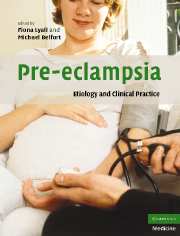Book contents
- Frontmatter
- Contents
- List of contributors
- Preface
- Part I Basic science
- Part II Clinical Practice
- 17 Classification and diagnosis of pre-eclampsia
- 18 Measuring blood pressure in pregnancy and pre-eclampsia
- 19 Immune maladaptation in the etiology of pre-eclampsia; an updated epidemiological perspective
- 20 Genetics of pre-eclampsia and counseling the patient who developed pre-eclampsia
- 21 Thrombophilias and pre-eclampsia
- 22 Medical illness and the risk of pre-eclampsia
- 23 The kidney and pre-eclampsia
- 24 Management of mild pre-eclampsia
- 25 Management of severe pre-eclampsia
- 26 The differential diagnosis of pre-eclampsia and eclampsia
- 27 Complications of pre-eclampsia
- 28 Central nervous system findings in pre-eclampsia and eclampsia
- 29 Pathogenesis and treatment of eclampsia
- 30 Anesthesia for the pre-eclamptic patient
- 31 Critical care management of severe pre-eclampsia
- 32 The role of maternal and fetal Doppler in pre-eclampsia
- 33 Pregnancy-induced hypertension – the effects on the newborn
- 34 Medico-legal implications of the diagnosis of pre-eclampsia
- Subject index
- References
21 - Thrombophilias and pre-eclampsia
from Part II - Clinical Practice
Published online by Cambridge University Press: 03 September 2009
- Frontmatter
- Contents
- List of contributors
- Preface
- Part I Basic science
- Part II Clinical Practice
- 17 Classification and diagnosis of pre-eclampsia
- 18 Measuring blood pressure in pregnancy and pre-eclampsia
- 19 Immune maladaptation in the etiology of pre-eclampsia; an updated epidemiological perspective
- 20 Genetics of pre-eclampsia and counseling the patient who developed pre-eclampsia
- 21 Thrombophilias and pre-eclampsia
- 22 Medical illness and the risk of pre-eclampsia
- 23 The kidney and pre-eclampsia
- 24 Management of mild pre-eclampsia
- 25 Management of severe pre-eclampsia
- 26 The differential diagnosis of pre-eclampsia and eclampsia
- 27 Complications of pre-eclampsia
- 28 Central nervous system findings in pre-eclampsia and eclampsia
- 29 Pathogenesis and treatment of eclampsia
- 30 Anesthesia for the pre-eclamptic patient
- 31 Critical care management of severe pre-eclampsia
- 32 The role of maternal and fetal Doppler in pre-eclampsia
- 33 Pregnancy-induced hypertension – the effects on the newborn
- 34 Medico-legal implications of the diagnosis of pre-eclampsia
- Subject index
- References
Summary
Introduction
Pre-eclampsia remains a leading cause of maternal and fetal morbidity and mortality. It is a pregnancy-specific multisystem disorder, occurring most commonly in primigravidae and characterized by the development of hypertension and proteinuria in the second half of pregnancy. The incidence in a second pregnancy is less than 1% in women who have had a normotensive first pregnancy, but is increased in women who have had pre-eclampsia in their first pregnancy, particularly in women whose first pregnancy was complicated by severe pre-eclampsia (Campbell et al., 1985). This issue is more completely discussed in the chapter by Dekker and Robillard in this book. The pathogenesis of pre-eclampsia is not fully understood but it is believed that genetic predisposition and immune maladaptation lead to placental ischemia and perturbation of the maternal vascular endothelium. Coagulation activation is an important feature and hypercoagulable states, including both inherited and acquired thrombophilias, have been associated not only with pregnancy thromboembolism but also with other adverse pregnancy events.
Normal hemostasis
The primary initiator of coagulation is tissue factor. Tissue factor (TF) is expressed by epithelial, stromal and perivascular cells throughout the body but not normally by cells in contact with the circulation. Following vascular damage, membrane-bound TF complexes with factor VII (FVII). Cleavage of FVII results in the formation of activated FVIIa. Thereafter TF–FVIIa complex can directly activate factor X (FX). TF–FVIIa complex may also activate FX indirectly via activation of factor IX (FIX).
- Type
- Chapter
- Information
- Pre-eclampsiaEtiology and Clinical Practice, pp. 305 - 324Publisher: Cambridge University PressPrint publication year: 2007



